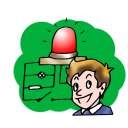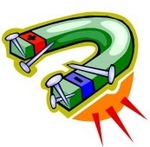
Worksheets and No Prep Teaching Resources
Reading Comprehension Worksheets
Electricity
Magnets

Electricity
 Worksheets and No Prep Teaching Resources Reading Comprehension Worksheets Electricity Magnets |
 Electricity |
| edHelper's suggested reading level: | grades 4 to 5 | |
| Flesch-Kincaid grade level: | 9.86 |
| Producing and Supplying Electricity: Garden of Amps |

|
 1 Most plants grow in pots or in gardens. However, some plants are made from steel and concrete. These plants are electrical power plants. They are very important to billions of people around the world who depend on electricity each day. The seeds for electrical power plants were planted during the 1800s. In 1819, a Danish scientist named Hans Christian Oersted made an accidental discovery. He found a link between electricity and magnetism. Oersted was investigating how electrical currents could produce heat when he noticed a strange sight. There was a compass on a nearby table. When the wires were connected in his circuit to the power source, the needle on the compass swung around. When he disconnected the wires, the compass needle returned to its normal position pointing towards the magnetic north pole. Electricity had magnetic pull!
1 Most plants grow in pots or in gardens. However, some plants are made from steel and concrete. These plants are electrical power plants. They are very important to billions of people around the world who depend on electricity each day. The seeds for electrical power plants were planted during the 1800s. In 1819, a Danish scientist named Hans Christian Oersted made an accidental discovery. He found a link between electricity and magnetism. Oersted was investigating how electrical currents could produce heat when he noticed a strange sight. There was a compass on a nearby table. When the wires were connected in his circuit to the power source, the needle on the compass swung around. When he disconnected the wires, the compass needle returned to its normal position pointing towards the magnetic north pole. Electricity had magnetic pull! |
Create Weekly Reading Books
Prepare for an entire week at once! |
| Leave your feedback on Producing and Supplying Electricity: Garden of Amps (use this link if you found an error in the story) |
 |
Electricity
|
 |
Magnets
|
 |
Science
|